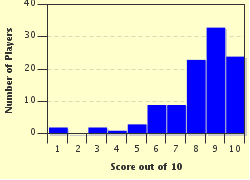Quiz Answer Key and Fun Facts
1. Though later made a significant hit by The Carpenters, this song was composed by Joe Raposo, one of the songwriters hired by "Sesame Street" and originally performed on the show by the adult cast members (such as Bob) and the Muppets (such as Big Bird). What is the name of this song that encouraged its listeners with these words: "Don't worry that it's not good enough / For anyone else to hear"?
2. What "Sesame Street" Muppet with a huge grin that stretches from ear to ear sits in a bathtub of suds and bubbles and sings these words to his favorite squeaky toy: "Rubber Duckie, you're the one. / You make bath time lots of fun / Rubber Duckie, I'm awfully fond of you"?
3. What furry green monster, who lives on Sesame Street, rises from his classic tin garbage can to sing "I Love Trash", which according to the song's lyrics includes one old worn and tattered shoe full of holes, smelly fish wrapped in newspaper over a year old, a broken clock, a rusted trombone, a broken umbrella, and an old telephone?
4. This googly-eyed, furry blue monster from "Sesame Street" stands behind a giant letter "C" to sing "C is for Cookie", and apparently that's "good enough" for him. He holds a chocolate chip cookie while he sings and later takes a bite out of it to remark how much like the letter "C" the cookie now looks. To which monster Muppet am I referring?
5. On "Sesame Street" in 1982, a superhero debuted appearing to be a purple rabbit wearing a cape and carrying a carrot and a bunch of celery. While he sings a song, he converts Andy, who is addicted to candy, and Eddie, who eats spaghetti, to lovers of vegetables. What is this Muppet's name, which also is the title of the song?
6. In 1973, Bert appeared in a skit by himself, an uncommon one because it was without Ernie. His entire body appears against a black backdrop, and the audience views his profile as Bert performs a dance that is essentially a strange strut. Bert imitates the walk of his favorite bird and sings a song, which ends with Bert's characteristic bleating laugh. What is the title of this song?
7. During one of the sketches of "Sesame Street", this purple-skinned, monocle-wearing vampire with pointy ears and a beaked nose lies in bed in his leopard-skin pajamas and sings of how depressed and frustrated he is that there is "Nothing to Count"--until he realizes he can imagine birdies and tubby elephants to count. What is the name of this character who is obsessed with counting?
8. On "Sesame Street" there is a song that occurs on several different episodes, and while the melody and chorus remain the same the verse lyrics change to teach listeners about different occupations. For example, one verse goes like this: "Oh, the postman always brings the ma-ail / Through rain or snow or sleet or ha-ail. / I'll work and work the whole day through / To get your letters safe to you". What is the name of this song that was first and most frequently sung by the human character Bob Johnson played by Bob McGrath?
9. In this animated "Sesame Street" sketch from 1971, these twelve little critters "ran sack races" and "fell on their backs and they fell on their faces". Then they jumped rope until "the rope it broke" and they "just sat around telling knock-knock jokes". Finally, they "talked about the high price of furniture and rugs / And fire insurance" while they roasted marshmallows around a fire. What song about "12" is this?
10. In 1970 during the first season of "Sesame Street", Kermit the Frog sat on a stump and sang a song about how difficult he found it to be a color that "blends in with so many other ordinary things". He wishes he could be another color, but as the song continues, Kermit ponders how his color "can be big like a mountain or important like a river or tall like a tree". He concludes that his color is "beautiful" and it is what he "want[s] to be". What is the name of this song?
Source: Author
alaspooryoric
This quiz was reviewed by FunTrivia editor
ladymacb29 before going online.
Any errors found in FunTrivia content are routinely corrected through our feedback system.

